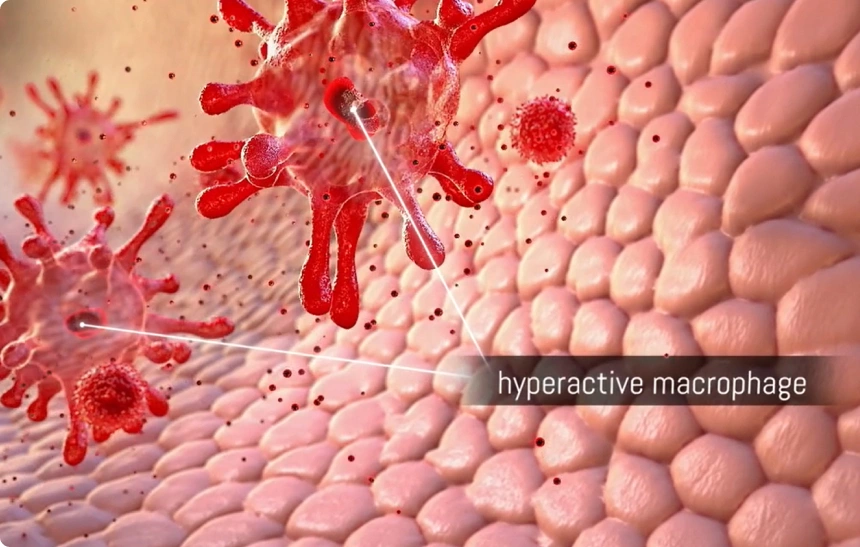Macrophage modulation as a therapeutic strategy against inflammatory diseases.
Disrupted inflammatory processes form the basis of many diseases. Macrophages, abundant throughout the body, are one of the key immune cells regulating these processes.

Macrophages are tissue-resident or infiltrating immune cells, critical for innate immunity, normal tissue development, and repair of damaged cells. Their function depends on the local micro-environment and the type of metabolites, substances, or pathogens to which they are exposed.
When triggered by disease, macrophages can deviate from their homeostatic state, becoming overactive and leading to the release of damaging cytokines. This contributes to the pathophysiology of various inflammatory disorders including sepsis and osteoarthritis.
Role in inflammation
Antigen presentation
Cytokine secretion
Phagocytosis
Immuno Modulation
Promoting balance:
apoptotic cells facilitate macrophage homeostasis.
Apoptosis, or programmed cell death, is a natural and essential process for maintaining tissue homeostasis. It results in the immediate removal of dying cells by macrophages and dendritic cells (DCs).
During apoptosis, cells exchange information to regulate diverse immunological responses in a context-dependent manner. The cell type, cause of cell death, microenvironment, quantity, and state of apoptosis can result in different immunomodulating signals, thus allowing the regulation of immune processes in different clinical settings. These signals may lead to pro-homeostatic effects mediated by macrophages and other antigen-presenting cells (APCs).
In our bodies, as many as 300 million cells undergo apoptosis every hour. Apoptotic cells themselves are major contributors to the “non-inflammatory” nature of the engulfment process:
- They express phosphatidylserine (PtdSer), a primary “eat me” signal that triggers their engulfment by macrophages.
- They produce “find me” and “tolerate me” signals to attract and immune – modulate macrophages and other cells.
- They secrete “calm-down” signals like thrombospondin-1 (TSP-1) or adenosine monophosphate (AMP) which interact with macrophages, and take them from an active to a normal, homeostatic state.
These properties make apoptotic cells an attractive therapeutic modality in acute inflammatory diseases such as sepsis and COVID-19, as well as other diseases that involve a chronic inflammatory component in their pathogenesis, such as osteoarthritis. Other potential therapeutic targets include diseases characterized by cytokine release syndrome (CRS), such as autoimmune diseases, organ transplantation, and graft-versus-host disease (GvHD).
Our ProgramsImmune homeostasis in macrophages
Apoptotic Cells Induce NF-κ8 and
Inflammasome Negative Signaling
Amir Gnau, Abi Tabib, Inna Grau, Inna Reiner, Dror Mevorach
Apoptotic Cells Induced Signaling for immune Homeostasis in Macrophages and Dendritic Cells
Uriel Trahtemberg and Dror Mevorach
Professor Dror Mevorach, Enlivex founder and executive scientific consultant, pioneered the research on the fate of dying (apoptotic) cells.
"In the last 25 years, I have tried to understand what happens to dying cells in our body. At the time that I began my research, our knowledge was limited, with only 3-4 articles on the subject. We created a group of investigators from all over the world and collaboratively worked together to understand the fate of dying cells. Amazingly, we started to realize that interaction with apoptotic cells leads to the reprogramming of macrophages and dendritic cells to a homeostatic state and polarizes them towards a resolution of inflammation. Realizing that, I spent 3 years looking for the perfect way to induce reproducible early programmed cell death and to turn it into a cellular therapy. It is exciting to realize the long way we have come since the early days of research and the hope we give nowadays to the unmet needs of a variety of patients."
VIEW PUBLICATIONS
